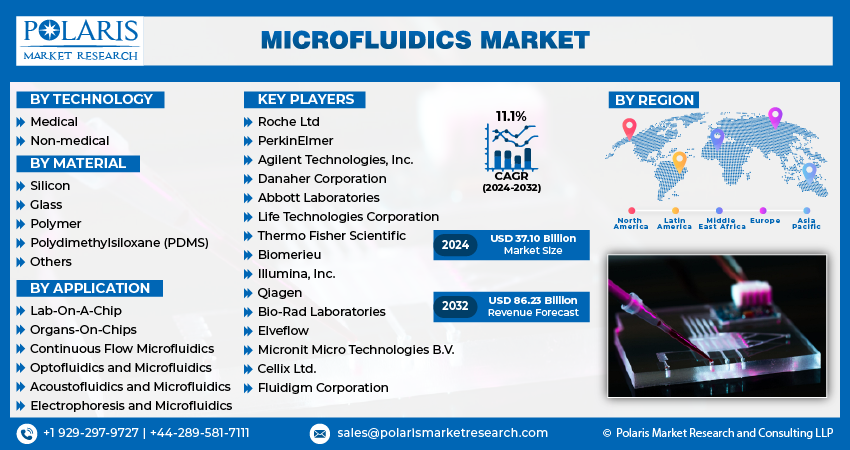Microfluidics, the science of manipulating and controlling fluids at the microliter or nanoliter scale, has emerged as a transformative technology in diverse fields such as healthcare, biotechnology, pharmaceuticals, and environmental monitoring. The global microfluidics market is projected to reach USD 86.23 billion by 2032, growing at an impressive CAGR of 11.1% during the forecast period. This growth underscores the pivotal role of microfluidic technologies in advancing diagnostic precision, drug development, and portable healthcare solutions.
This article delves into the market dynamics of microfluidics, exploring its growth drivers, emerging trends, challenges, opportunities, and the vast potential it holds for reshaping industries.
Market Overview
Microfluidics combines principles of engineering, physics, chemistry, and biotechnology to develop systems capable of performing multiple laboratory functions on a single chip. These “lab-on-a-chip” (LOC) technologies are compact, cost-effective, and capable of delivering rapid results, making them invaluable in diagnostics, drug discovery, and point-of-care (POC) testing.
The global microfluidics market’s exponential growth is fueled by innovations in diagnostics, increasing adoption of personalized medicine, and advancements in miniaturized medical devices. The demand for portable, fast, and accurate diagnostic tools, coupled with technological innovations, positions microfluidics as a cornerstone in the future of healthcare and biotechnology.
Some of the major players operating in the global market include:
- Roche Ltd
- PerkinElmer
- Agilent Technologies, Inc.
- Danaher Corporation
- Abbott Laboratories
- Life Technologies Corporation
- Thermo Fisher Scientific
- Biomerieu
- Illumina, Inc.
- Qiagen
- Bio-Rad Laboratories
Key Market Drivers
- Increasing Demand for Point-of-Care Diagnostics The growing prevalence of chronic diseases and the need for rapid, accurate diagnostic solutions are driving the adoption of point-of-care testing. Microfluidic devices, due to their compact design and ability to provide quick results, are ideal for decentralized testing, reducing the burden on traditional healthcare systems.
- Rising Prevalence of Chronic and Infectious Diseases The increasing incidence of diseases such as cancer, diabetes, and cardiovascular conditions, along with the recent global focus on infectious diseases like COVID-19, has amplified the demand for efficient diagnostic tools. Microfluidic devices, with their high sensitivity and specificity, are playing a critical role in early disease detection and monitoring.
- Advancements in Drug Discovery and Development Microfluidics is revolutionizing drug discovery by enabling high-throughput screening and precise control over experimental conditions. Pharmaceutical companies are increasingly leveraging microfluidic platforms for cell-based assays, drug delivery studies, and toxicity testing, driving market growth.
𝐄𝐱𝐩𝐥𝐨𝐫𝐞 𝐓𝐡𝐞 𝐂𝐨𝐦𝐩𝐥𝐞𝐭𝐞 𝐂𝐨𝐦𝐩𝐫𝐞𝐡𝐞𝐧𝐬𝐢𝐯𝐞 𝐑𝐞𝐩𝐨𝐫𝐭 𝐇𝐞𝐫𝐞:
https://www.polarismarketresearch.com/industry-analysis/microfluidics-market
Emerging Trends
- Integration with Wearable Devices The convergence of microfluidics with wearable technology is a burgeoning trend. Microfluidic sensors integrated into wearables can continuously monitor health metrics such as glucose levels, hydration status, and stress markers, enabling real-time health management.
- Adoption in Environmental Monitoring Beyond healthcare, microfluidics is finding applications in environmental monitoring, where it is used for detecting pollutants, pathogens, and toxins in water, air, and soil. The portability and efficiency of microfluidic devices make them well-suited for on-site testing in remote or underserved areas.
- Microfluidics in Food Safety The food and beverage industry is adopting microfluidic technologies for quality control and contamination detection. These devices enable rapid screening of food products for pathogens, allergens, and chemical contaminants, ensuring compliance with safety standards.
Market Challenges
- High Initial Costs The development and integration of microfluidic systems involve significant costs, including materials, fabrication, and device calibration. These high initial costs can be a barrier for smaller companies or research institutions.
- Complex Regulatory Landscape The stringent regulatory requirements for diagnostic and medical devices can delay product approvals and market entry. Navigating these regulations, particularly for novel microfluidic technologies, remains a challenge for manufacturers.
- Scaling from Lab to Market While microfluidic prototypes often perform well in controlled laboratory settings, scaling up for mass production while maintaining quality and consistency can be complex and resource-intensive.
Future Outlook
The future of the microfluidics market is bright, with advancements in materials science, device miniaturization, and digital integration paving the way for innovative applications. As the demand for portable, efficient, and accurate diagnostic tools continues to rise, microfluidics is set to become an integral part of modern healthcare and beyond.
In the pharmaceutical sector, microfluidics will drive innovation in drug discovery and personalized medicine, while its applications in environmental monitoring, food safety, and synthetic biology will open new avenues for growth. The integration of artificial intelligence (AI) and machine learning with microfluidic platforms will further enhance their analytical capabilities, enabling predictive diagnostics and precision therapy.
𝐒𝐞𝐠𝐦𝐞𝐧𝐭𝐚𝐥 𝐎𝐯𝐞𝐫𝐯𝐢𝐞𝐰:
The research report categorizes the market into various segments and sub-segments. The primary segments covered in the study include type, application, end use and region. The splitting of the market into various groups enables businesses to understand market preferences and trends better. Also, stakeholders can develop products/services that align with the diverse needs of consumers in the industry. Besides, the research study includes a thorough examination of all the major sub-segments in the market.
Microfluidics, Technology Outlook (Revenue – USD Million, 2019-2032)
- Medical
- PCR & RT-PCR
- Gel Electrophoresis
- Microarrays
- Enzyme-linked Immunosorbent Assay (ELISA)
- Others
- Non-medical
Microfluidics, Material Outlook (Revenue – USD Million, 2019-2032)
- Silicon
- Glass
- Polymer
- Polydimethylsiloxane (PDMS)
- Others
Microfluidics, Application Outlook (Revenue – USD Million, 2019-2032)
- Lab-On-A-Chip
- Organs-On-Chips
- Continuous Flow Microfluidic
- Optofluidics and Microfluidic
- Acoustofluidics and Microfluidics
- Electrophoresis and Microfluidics
Conclusion
The global Microfluidics Market, projected to reach USD 86.23 billion by 2032, represents a transformative force across industries. With its ability to deliver precise, rapid, and cost-effective solutions, microfluidics is revolutionizing diagnostics, drug development, and environmental monitoring. While challenges such as high costs and regulatory hurdles persist, the opportunities for innovation and expansion in emerging markets are vast. As the technology continues to evolve, microfluidics is poised to redefine the future of diagnostics and therapeutics, offering unprecedented potential for improving health and quality of life globally.
More Trending Latest Reports By Polaris Market Research:
Reduce your Stress with Meditation Management Apps Market
Carbon Accounting Software Market

